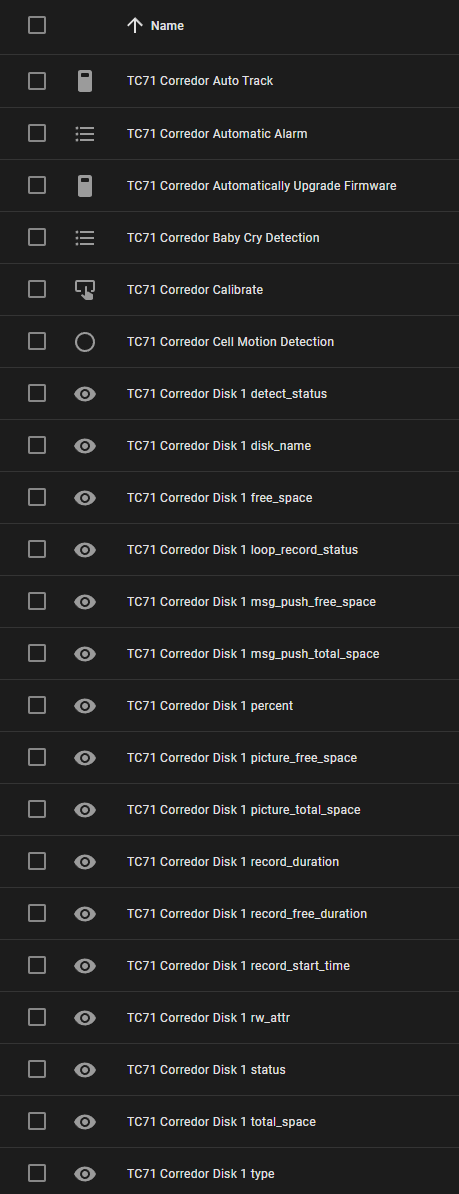My girlfriend is be very interested in putting Blink (Amazon) cameras up around our property. I am not interested in paying Amazon to keep our security footage.
What I’d like to do is have motion activated internet connected cameras around the property that somehow send footage to a server (I don’t know if that’s the correct term, I’m kind of an idiot) that I keep on the property.
So I have three questions:
- is this the right forum to be asking about self hosting security footage?
- does anyone here have experience doing this and would they be willing to send some pointers my way?
- is this a feasible DIY project or am I better served paying for a service?
I’ve done a little digging into self hosting and it’s not cheap, but I think it will be cheaper than paying a subscription. And safer too, which is rad.
Thank you all!
Reolink cameras look like they check all of your boxes. They can be self contained systems with a “recorder box” (actual term is NVR) that you keep on your property out of harms way or it can be a DIY PC with a program called Blue Iris. There is a variety of cameras to choose from with different features like Wifi, POE, PTZ, solar powered, etc. Spend as little or as much as you want. As you mentioned in your post, this will be pricey up front but will be cheaper in the long run.
Reolink is a Chinese company. Not known for their privacy. My experience with their cameras is the quality is meh and their software is even more meh. It amazes me how often they get recommended. I guess it’s due to their cheapness.
Their quality is adequate for the price and they are open enough to be used with any NVR.
If you are worried about privacy you should segment the cameras onto their own network (VLAN) or at the very least block them on the firewall from accessing the internet, which you should do anyway.
It’s more because they provide an ONVIF interface or an RTSP stream that makes them self-hosting darlings. Them being Chinese white-labels and cheap is mainly a side-bonus.
What are your recommendations if not them?
You’re not wrong about reolinks, amcrest, hikvision, etc but their price:quality can’t be beat and they work well with many different NVR software suites, which makes them popular.
If you’re concerned about how they call home (they do, I’ve sniffed packets on my network to test the rumors and seen it on every one of them), you need to isolate the cameras off of the internet so they are blocked from the outside connection. This can end up being mildly tricky to very complicated depending on your network equipment, the way your LAN is set up at home, whether you want to view your cameras remotely, etc, but it’s the most cost effective long term option that is not subscription/cloud based.
I use blue iris on an old computer. It works great. I have unifi network gear, and I tried some of their cameras out but they’re not really ONVIF compliant and they’re extremely expensive for an equivalent Chinese brand. That’s the made in USA price, and tbh Unifi cameras aren’t even that expensive, they’re more “prosumer” for small business deployments or nerds at home. They have a walled garden ecosystem that I dipped my toe into and didn’t care for some of it, but I still use their access points, routers, and switches because they’re great quality and really easy to config.
But, if you have never done any of that, you might just want to go with an off the shelf solution or be willing to spend a lot of time reading. You DON’T want to mess up your network security trying to install local cameras if you’re not sure what you’re doing.
One thing that hasn’t been mentioned yet is an RF/analogue camera kit. It’s not as easy to set up as POE (two cords to each camera and they’re way bigger so running them through walls will do more damage that you have to patch later) you can get an all-in-one NVR+4/8/12/16 etc camera kit with as many bells and whistles as you want. It will be cheaper as well and you don’t have to worry about network bandwidth issues because it’s analog. The feeds are super nice.
While Reolink hardware is perfect for Blue Iris and other self-hosted solutions, I try to warn everyone that Reolink’s own Android app now captures your device’s clipboard whenever accessed. The same may be true for their desktop or iOS apps, I don’t know.
I have several Reolink cameras and I’ve been happy with their overall image quality and capabilities, but I do not trust their software whatsoever and recommend keeping them isolated from the internet entirely.
I have been using Reolink RC-522s outside in the harsh Canadian cold winters. Even at -40 they kept working and their quality hasn’t degraded.
I tried out q few options for NVR software, and I’ve settled on Frigate NVR, it was pretty painless to setup and “just worked”.
Shinobi I found worked at first but three times it shit the bed, silently failed one day, and just stopped working. I’d wipe and re-install and it’d just fail after awhile. Frigate has never had this issue so far.
I use Power over Ethernet for the cameras, so i only had to run 1 single cable (ethernet) to each camera outside, no need to run high voltage which makes it way easier to install.
I use a small mini itx PC as the NVR with a 960ti installed in it for transcoding.
I have a fancy managed 48 port gigabit poe switch which is overkill for just cameras (I have tonnes of other PoE devices on my network as well justifying it), but any “dumb” gigabit poe switch will work for you, as long as you have enough ports for your cameras.
I personally use kubernetes for my machines running self hosted apps, but for most folks that’s overkill abd you can just use docker compose!
Second for Reolink. I’m just using local SDcard storage atm, but might consider something like Frigate, just hasn’t been needed yet. Got 3 cameras and 2 doorbells, all hooked into Home Assistant.
Reolink or amcrest cameras paired with (software) frigate, blue iris, motioneye, shinobi, etc etc works fine.
Yeah i am using Blue Iris paired with Amcrest, Reolink and a few random other cameras. Works really well.
A lot of the more modern NVR systems can be accessed from the internet. So you can use these.
Synology has security station on their NAS systems (although there is some licensing nowadays depending on model and number of cameras.
Ubiquity also offers local storage for their system, that also offers a bellcam (like ring) and different in and outdoor camera models.
Good luck!
Hell, I had a Harbor Freight system years ago that was all local (with a DVR), with an app I could view remotely.
Had to open some ports on my firewall/router, of course, so not ideal, and not what I’d recommend today.
If I still had that system, I’d use Tailscale to access it.
Thank you! I’ll check those out!
Another brand you might want to look into is Reolink. Whether it’s just for the cameras (with something like frigate & home assistant) or cameras and NVR combo.
Check out the YouTube channel the hook up, dude does really great comparison vids of different camera models and brands
Ubiquiti is good, if you have the money. I have an 8TB HDD in my UDM-PRO recording 24/7 the footage from 6 cameras. It isn’t a cheap solution but it works and it’s local.
How long does it take to fill that storage?
Depends on your setup, I used to have 4 cameras that only saved when motion was detected and they filled 1tb in about a month.
Most cameras that can support RTSP streaming can be used for self-hosting, then you just need a good video recording / storage system. I used a mix of 3 different types of cameras, streaming RTSP to be recorded by Zoneminder.
You can research the different NVR / recording systems to find what suits you.
Zoneminder
Indeed. I’ve been using ZM for personal and commercial camera setups (for up to 32 cameras) since around 2006. Great piece of software - does what it does quietly and without fuss and is completely free.
Dahua/Loryta + Frigate + Home assistant
You can do object detection and recording with Frigate. Notifications and actions on events with Home Assistant.
You can use just about any camera with Frigate in general, but I prefer Dahua because that’s what’s tested by the frigate team… and the new PTZ features work great with the Dahua cameras. So a camera can watch a normal area… and if it detects a person (or whatever object you set) will lock onto that person and follow them around until it can’t any longer then return to the original “normal” position. It’s great.
The downfall is that this requires a lot of initial configuration effort on your end, but the software is all free, with no requirements to pay for anything at all outside of the hardware. Something else to keep in mind is that if you’re self-hosting… and the device you host on is stolen, the footage goes with it. There’s lots of little boxes on amazon that run Frigate really well. Anything with an N100 for instance will run many streams just fine (I have 3 cameras setup on the little guy for my grandfather to keep an eye on him, using about 1/8th the total resources, so could probably handle up to 10-12 cameras quite easily.)
On a related topic, Insecam is a website that shows live streams from insecure cameras. It’s a great example on why privacy matters in every aspect of your life, even if you don’t think it affects you personally.
I use ubiquiti cameras and nvr for this purpose, might not be open source but I keep all the footage locally, it’s easy to use and feature rich
I 2nd this as I use them too. However, Ubiquiti devices are not cheap.
Cameras in general aren’t as easy as cheap plugs to deal with. There’s the OpenIPC project but it seems only to support very specific chips that are sometimes older, hard to find or not price/feature competitive like something such as what TP-Link offers.
For what’s worth TP-Link Tapo cameras (TC70, 71 etc.) aren’t that bad when it comes to privacy, there isn’t much “cloud”. They do require you to use their mobile app and cloud to setup the camera but afterwards you can just run them on an isolated VLAN / firewall them from the internet completely and you’ll still be able to use all of the camera’s features. Those cameras provide a generic rtsp stream that even VLC can play and there’s also a good HA integration that provides all features of the TP-Link Tapo application like pan / move / download recordings from the camera’s SD card and whatnot 100% locally / offline.
I particularly like their cameras because they’re really cheap and decent, while not perfect in terms of privacy they’ve a good trade off when it comes to price but require initial cloud setup. They also have wireless versions, ethernet versions and a cheap PoE splitter will be good for those.
They do require you to use their mobile app and cloud to setup the camera but afterwards you can just run them on an isolated VLAN / firewall them from the internet completely
Do you have any good guides or articles diving deeper on this? I was also pondering Home Assistant - it supports tapo devices, but I don’t know much about it. Would that be a possible solution?
and you’ll still be able to use all of the camera’s features
would this include a live cam feed?
Home Assistant - it supports tapo devices, but I don’t know much about it. Would that be a possible solution?
I just told you it works fine under Home Assistant and provided a link to the integration. https://github.com/JurajNyiri/HomeAssistant-Tapo-Control
would this include a live cam feed?
Yes. It includes, live feed, the ability to move the camera, ring the bell, turn on privacy mode, enable patrol mode… and use the camera’s sensors. There’s also an option to automatically download recorded video on the camera’s SD card every x hours or days. Here’s the full list of entities available under HA for those cameras (note that your camera must support the feature):



Sorry, didn’t click the link, didn’t realize HA stands for Home Assistance there. As you can tell, pretty new to this. Thanks for the answer!
Sure, no problem. The bottom line is that it works very well for the low price of those cameras and I couldn’t be happier.
If you wouldn’t mind, could you share how you managed to make the Tapo cameras work with Home Assistant? I finally got it set up and while I had no isse with bulbs, cameras just can’t be adde through the TP Link integration. There are no Tapo cameras listed as supported on the Home Assistant web eithet
As I said before, you’ve to install this: https://github.com/JurajNyiri/HomeAssistant-Tapo-Control then go to Settings > Devices > Add and search for Tapo.
I guess that’s the issue - I assume this needs to be installed on the hardware running the Home Assistant. I went with the easy option of getting the Home Assistant Green hub, so I don’t assume there is a way for me to make it work… or it’s just beyond my capabilities
Thanks anyway for your patience with me, unknowingly asking the same damn thing over and over like a dummy.
deleted by creator
It seems to be possible to stream audio to the camara and there’s some discussion about getting 2-way audio using WebRTC but it isn’t going anywhere: https://github.com/JurajNyiri/HomeAssistant-Tapo-Control/issues/99
deleted by creator
My cheap and cheerful, but not very secure homebrew solution is a used smartphone, then load any of the motion-detection apps onto it, plus an FTP server app. Then place the phone anywhere within Wi-Fi reach. Run a script once a day on my home server that downloads and deletes the videos from the phone via FTP, and also deletes that footage after 30 days. So the “system” can run indefinitely without running out of memory. The old phones just need to be rebooted once in a while for some odd reason.
Phones and their batteries aren’t made for this. Trying to run a phone 24/7 will likely result in the phone dying very quickly and raise the chances of it exploding.
My oldest “security camera” of this type has been online 24/7 since June 2019 and permanently connected to a charger of the smallest type I could find at that time. The battery still holds a charge when I take the phone down for cleaning. Not sure how old the phone itself is (a small Kyocera), probably a 2014 or 2015 model. So, for my requirements, I’d say, it’s reasonably reliable.
OTOH, you may be right, and they don’t make them like they used to in the olden days, haha.
Some or maybe even most phones will survive, but there’s a reasonable chance of the device going up in flames. Older batteries are even more likely to catch fire, depending on the type.
For software I’d recommend using Frigate for ally the processing and then integrating it with Home Assistant.
deleted by creator
You might want to look into Hivision cameras (or oem versions like Annke) and frigate NVR. All you need is a pc and some basic linux knowledge.
I have exactly zero Linux knowledge but I know people who do!
I’m using a bunch of wyze cam 3 cameras with the wzmini custom firmware installed and outside connections turned off. They took a while to figure out how to set up since I’d never had to deal with ssh keys before but after set up they are pretty bulletproof.









